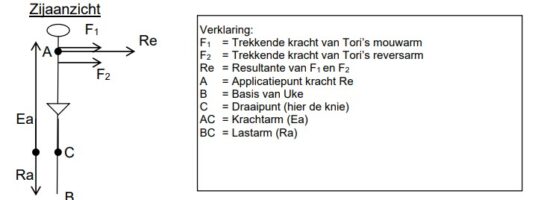Hiza-guruma 膝車
Knee Wheel
Classification: Ashi-waza (Foot/Leg Technique)
Japanese meaning:
-
Hiza = knee
-
Guruma = wheel
Technical Description
A classic judo foot technique. Similar to Sasae-tsurikomi-ashi, Hiza-guruma breaks uke’s balance toward the right front corner. As uke steps forward, tori uses the sole of the left foot to block or ‘wheel’ against uke’s right kneecap.
With this leg in place as a pivot, tori simultaneously pulls the upper body forward and to the side using both arms. This combination of blocking the leg and pulling the torso causes uke to rotate around the knee and fall cleanly onto their back.
The secret lies in timing, balance breaking (kuzushi), and smooth coordination of the hands and foot placement.

Biomechanics of Hiza-guruma
This technique functions as a lever:
-
Tori’s blocking foot creates a fulcrum just below uke’s knee (point C).
-
The arms (F1 and F2) act as force vectors, pulling uke in a horizontal arc.
-
This causes uke to rotate and fall over the knee block in a controlled and circular motion.
Key note: If the pulling direction is downward, the throw is likely to stall. The hands must guide uke’s upper body horizontally and upward, preserving momentum around the knee pivot.

-
-
Did You Know?
Within the ashi-waza category, there are three distinct types of leg techniques in judo:
-
Sweeping Techniques (Harai-waza):
-
Example: De-ashi-harai, Okuri-ashi-harai
-
These target an unweighted or moving foot.
-
-
Reaping and Hooking Techniques (Gari and Gake):
-
Example: O-soto-gari, Ko-uchi-gari
-
These attack a weighted leg to reap or hook it.
-
-
Blocking Techniques (Ashi-barai / Guruma-type):
-
There are only two true examples:
-
Hiza-guruma
-
Sasae-tsurikomi-ashi
-
-
These stop uke’s leg from stepping while rotating the upper body over it.
-
A Legendary Favourite
Did you know that Hiza-guruma was one of the favourite techniques (tokui-waza) of Anton Geesink, the greatest Dutch judoka of all time? His mastery of this throw, combined with his size and timing, made it especially devastating. This elegant technique highlights judo’s central philosophy of maximum efficiency with minimum effort—turning even the smallest contact point, like a knee, into a powerful lever.
-
-